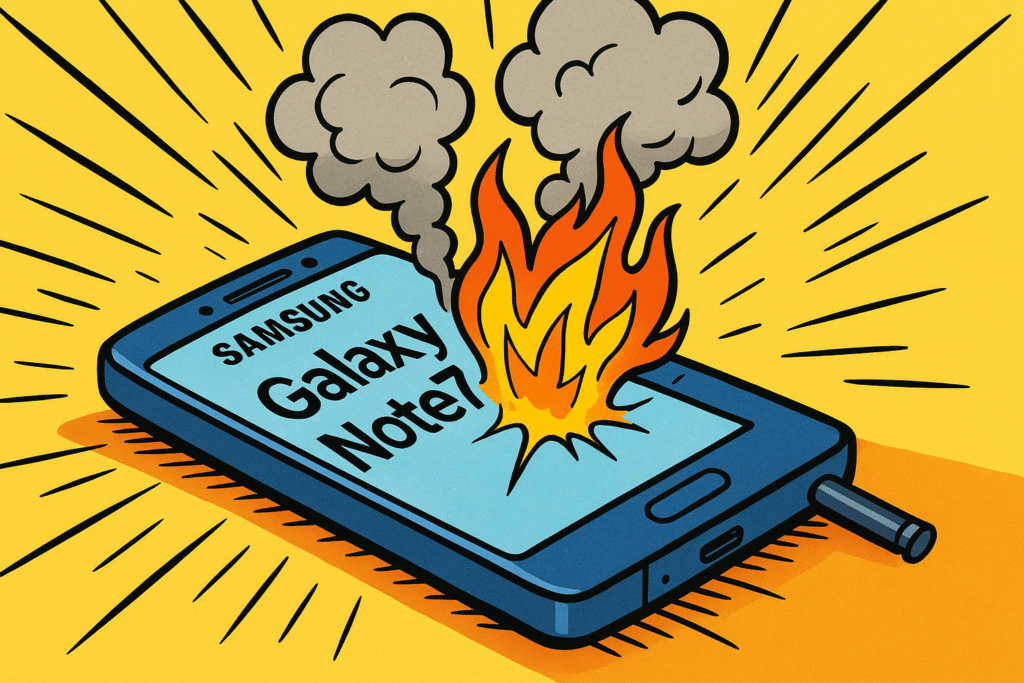Unveiling the Spark: How Samsung Note7 Battery Lies Ignited a Global Crisis

The Samsung Note7 Battery Lies scandal remains one of the most notorious product-safety failures in tech history. What began as an “isolated battery cell issue” quickly escalated into a global crisis, as both original and replacement Galaxy Note7 units continued to catch fire. This article delves into how Samsung’s initial narrative unraveled under mounting evidence—from regulatory warnings and leaked internal documents to independent lab findings—and examines the far-reaching impact of those early missteps.
Table of Contents
The Galaxy Note7 Launch and Early Reports
The Samsung Galaxy Note7 officially launched on August 19, 2016, to strong pre-order numbers in South Korea and high anticipation worldwide. Source: Wikipedia
Boasting features like:
- A curved-edge Quad HD display
- Iris-scanning security
- The return of expandable storage
…it was positioned as Samsung’s flagship phablet.
Despite extensive pre-release testing and quality-control checks, the first reports of overheating began surfacing just days after launch—catching both Samsung and consumers off guard.
Early Incidents and Warnings
By late August 2016, social media and online forums were flooded with alarming images of:
- Scorched chargers
- Melted phone housings
Within the first three weeks, Samsung had received:
- 92 reports in the U.S. of overheating batteries
- 26 burn injuries
- 55 cases of property damage (from cars to garages)
Source: CPSC.gov
One of the most serious incidents occurred when a Note7 began smoking mid-flight on a Southwest Airlines plane, requiring immediate response from crew and firefighters.
Source: ResearchGate.net
These incidents not only highlighted the severity of the defect, but also made it clear that no environment—home, office, or airplane—was immune to risk, despite Samsung’s initial reassurances.
Samsung’s First Response
On September 2, 2016, Samsung publicly addressed the growing Note7 fire reports, framing the issue as limited and under control.
Key Points of the Statement
- Immediate Action: Advised all Galaxy Note7 owners to “turn off the power” and return or exchange their devices.
- Blame on Battery Cells: Attributed the fires to “an isolated battery cell issue” affecting early-production units from a single supplier.
- Promise of Safe Replacements: Pledged that replacement units would be fitted with batteries that had passed Samsung’s safety checks.
“We take the highest priority in safety and apologize to our customers for the inconvenience caused by this matter. We have mobilized our global network of partners to replace all affected devices and will work closely with carriers, retailers, and regulators to ensure a seamless exchange process.”
—Samsung Official Statement, September 2, 2016
What Was Claimed vs. What Happened
- Claimed only one vendor’s batteries were at fault.
- Assured consumers that replacement phones would be safe.
- Set expectations for a quick resolution—an approach later proven overly optimistic.
For the full text of Samsung’s original statement, see their announcement here:
Read Samsung’s September 2, 2016 Statement on Galaxy Note7
Recurrence of Fires in Replacement Units
Samsung’s replacement program was intended to stem the crisis—but by mid-September 2016, it had only made matters worse. Despite assurances that new batteries came from an alternate supplier and had passed “rigorous internal safety checks,” replacement Galaxy Note7 units continued to suffer dangerous failures.
Notable Incidents
- In-Flight Blaze
On October 5, 2016, a replacement Note7 erupted in flames aboard Southwest Airlines Flight 994, forcing an emergency evacuation upon landing in Louisville, Kentucky (Reuters). - Home Charger Meltdowns
Users reported wall chargers literally melting into plastic puddles during overnight charging—leaving scorched nightstands and ruined furniture. - Thermal Runaway Across the Board
Even “fixed” phones showed the same uncontrolled heat-build-up and ignition, indicating the underlying defect was not addressed.
“The lithium-ion battery in the Galaxy Note7 smartphones can overheat and catch fire, posing a serious burn hazard to consumers.”
—U.S. Consumer Product Safety Commission, September 15, 2016 (CPSC Recall)
Global Consequences
- Airline Bans: Carriers worldwide forbade Note7 devices in cabins and cargo holds.
- Carrier & Retail Response: Major networks (AT&T, Verizon) and retailers suspended all exchanges.
- Systemic Safety Failure: A second recall of nearly 1 million units made it clear the problem extended beyond a single supplier.
By replacing batteries without re-examining phone design and manufacturing processes, Samsung inadvertently amplified the crisis—proving that a supplier swap alone could not resolve the root causes of the Note7 fires.U.S. Consumer Product Safety Commission officially recalled about 1 million units, warning that “the lithium-ion battery in the Galaxy Note7 smartphones can overheat and catch fire, posing a serious burn hazard” (CPSC).
The Truth Emerges: Dual Battery Defects
In January 2017, Samsung convened a press conference in Seoul to present the comprehensive results of its investigation. DJ Koh, President of Mobile Communications, acknowledged that the crisis stemmed from two distinct manufacturing faults—one in each of the batteries’ supply chains.
Identified Defects
- Samsung SDI Cells:
- Internal electrode misalignment during assembly
- Under normal stress (e.g., bending or swelling), the misaligned electrodes could puncture the separator, leading to short-circuits and thermal runaway
- CATL (ATL) Cells:
- Welding defects at the junction points
- Insufficient insulation allowing electrode and casing contact, triggering overheating
“We deeply apologize to our customers for the anxiety and inconvenience caused. Our thorough analysis shows that both suppliers’ batteries failed to meet our stringent safety criteria, and we take full responsibility.”
—DJ Koh, Samsung Mobile President, January 23, 2017
These revelations contradicted Samsung’s earlier assertion of a single “isolated” issue. By exposing dual faults, the company admitted that its quality-control processes and design tolerances were insufficient to prevent either type of defect from causing catastrophic failures.
For the full technical breakdown and official apology, see Samsung’s January 23, 2017 press release:
Samsung Electronics Announces Cause of Galaxy Note7 Incidents
Leaked Documents and Industry Scrutiny

As the Note7 crisis deepened, confidential communications and expert analyses painted a broader picture of systemic failure. It became clear that design choices and corporate culture both played roles in downplaying early warnings.
Key Findings from Leaked Documents and Analysts
- Tight Design Tolerances: Samsung’s slim form factor left only millimeters of clearance around the battery, increasing the risk that even minor manufacturing defects—such as misaligned electrodes or poor welds—could lead to short-circuits.
- Early Warning Suppressed: Internal emails show engineers flagged overheating incidents during initial testing, but managers delayed escalation to avoid jeopardizing the August launch date.
- Overreliance on Suppliers: Rather than re-evaluating the phone’s design, Samsung initially focused blame on external vendors, ignoring signals that the device architecture itself needed revision.
“It was surprising if [Samsung] said it was a supplier issue only.”
—Industry Analyst
For an in-depth technical breakdown of how these hidden pressures and design choices combined to ignite the Note7 fiasco, see WIRED’s detailed report:
WIRED: What Really Went Wrong with the Galaxy Note7
Financial and Reputational Fallout

The Galaxy Note7 debacle inflicted both a heavy financial toll and lasting damage to Samsung’s reputation. What began as a mid-range profit hit soon ballooned into billions in losses and a crisis of consumer trust.
Major Impacts
- Financial Losses:
- Initial estimates placed the cost to Samsung between $5–6 billion in lost operating profits and recall expenses over three consecutive quarters entrepreneur.com.
- Subsequent analyses by Credit Suisse and other financial institutions suggested revenue shortfalls could top $17 billion when accounting for lost sales projections and market share erosion reuters.com.
- Global Recall Scope:
- Over 2.5 million Note7 units were recalled or replaced worldwide, representing one of the largest technology recalls in history.
- Permanent Discontinuation:
- On October 10, 2016, Samsung “asked all carrier and retail partners globally to stop sales and exchanges.”
- On October 11, 2016, the company officially permanently discontinued the Galaxy Note7 model reuters.com.
“We have asked our carrier and retail partners globally to stop sales and exchanges effective immediately, and we sincerely apologize for the inconvenience to our customers.”
—Samsung Official Statement, October 10, 2016 reuters.com
Reputational Damage
- Market Trust: Analysts warned that the recall would tarnish Samsung’s brand image, making consumers and carriers more cautious about future flagship releases.
- Investor Reaction: Samsung’s share price plunged, wiping billions off its market valuation in the days following the second recall and discontinuation.
- Legal and Regulatory Scrutiny: Class-action lawsuits and governmental investigations into product safety practices followed, extending the crisis beyond immediate financial costs.
This combination of massive direct losses, widespread recalls, and eroded consumer confidence marked the Galaxy Note7 saga as one of the costliest and most impactful safety failures in the consumer electronics industry.
Aftermath and Reforms
In response to the Note7 disaster, Samsung embarked on a comprehensive overhaul of its battery safety and product development protocols, aiming to ensure such a failure never recurs.
1. Eight-Point Battery Safety Check
Samsung instituted a multi-stage testing regimen, including:
- Durability Tests: Simulating drops, bends, and punctures.
- Charge/Discharge Cycling: Repeating charge cycles well beyond normal use.
- X-ray & CT Imaging: Inspecting internal cell structures for hidden flaws.
“We have implemented the most rigorous battery testing protocols in the industry to protect our customers.”
—Samsung Safety White Paper, Q1 2017
2. Independent Advisory Group
To lend external oversight, Samsung convened a panel of experts from:
- UL (Underwriters Laboratories)
- Exponent (Engineering & Scientific Consulting)
- TÜV Rheinland (Global Testing & Certification)
This advisory group reviews every new battery design and certifies compliance before production.
3. Revised Design Guidelines
- Increased Cell Clearance: Greater physical separation between the battery and surrounding components to reduce stress.
- Enhanced Thermal Monitoring: Additional sensors to detect abnormal temperature rises in real time.
- Fail-Safe Firmware: Software mechanisms to throttle or shut down charging if irregularities are detected.
These reforms have been credited with restoring consumer trust in Samsung’s subsequent flagships—evident in the successful launches of the Galaxy S8, Note8, and beyond—demonstrating that thorough accountability and rigorous safety standards can rebuild a brand’s reputation.
Conclusion
The fallout from the “Samsung Note7 Battery Lies” saga underscores the critical importance of transparency and rigorous safety testing in the fiercely competitive world of consumer electronics. What began as a single “isolated battery cell issue” spiraled into a full-blown global crisis, revealing that:
- Downplayed Defects
Samsung’s initial narrative blamed a lone supplier’s batteries, obscuring the reality that two distinct manufacturing faults lurked beneath the surface. By underplaying these risks to protect its launch schedule, the company compromised customer safety and trust. - Costly Consequences
The recall and discontinuation of over 2.5 million devices inflicted a staggering $5–6 billion hit to operating profits—an amount that grew even larger once lost sales and market share erosion were factored in. Beyond the balance-sheet impact, Samsung’s brand image suffered a blow that took years of careful product stewardship to repair. - Erosion of Consumer Confidence
When both original and replacement Note7 units continued to ignite, users and regulators alike felt betrayed. Airlines banned the device from cabins, carriers halted exchanges, and governments launched safety investigations, signaling a complete breakdown in the company’s quality-assurance processes.
Yet, from this debacle emerged a blueprint for accountability:
- Eight-Point Battery Safety Check
A multi-stage battery validation process—encompassing mechanical stress tests, thermal imaging, and extreme-cycle charging—now precedes production. - Independent Advisory Panel
External experts from UL, Exponent, and TÜV Rheinland audit every new battery design, ensuring an unbiased review beyond in-house testing. - Revised Design Standards
Enhanced physical clearances, additional thermal sensors, and fail-safe firmware work in concert to detect and neutralize cell anomalies before they can cause harm.
These reforms have not only safeguarded subsequent flagship releases but also demonstrated that honesty and accountability can be powerful catalysts for rebuilding trust. The Galaxy Note7 incident stands as a sober reminder: in the high-stakes arena of modern technology, no product milestone is worth sacrificing the well-being of customers or the integrity of the development process.
Frequently Asked Questions (FAQ) – Battery Lies
1: What caused the Galaxy Note7 fires?
Two separate battery defects were to blame—misaligned electrodes in Samsung SDI cells and welding faults in CATL (ATL) cells—each leading to internal short-circuits and thermal runaway.
2: When did Samsung first acknowledge the issue?
Samsung issued its first recall on September 2, 2016, attributing fires to “an isolated battery cell issue” in early-production units.
3: Why did replacement Note7 units also catch fire?
Replacement batteries—sourced from a different supplier—still had manufacturing flaws. This second wave of incidents revealed that the root cause was not limited to one vendor.
4: How much did the Note7 recall cost Samsung?
Estimates put the financial hit at $5–6 billion in lost profits over three quarters, plus reputational damage and comprehensive recall logistics.
5: What safety measures did Samsung implement afterward?
Samsung introduced an eight-point battery safety check, formed an independent advisory group (UL, Exponent, TÜV Rheinland), and updated design guidelines to increase cell clearance and improve thermal monitoring.
Sources – Battery Lies
- Samsung Galaxy Note7 Wikipedia
https://en.wikipedia.org/wiki/Samsung_Galaxy_Note_7 - Samsung’s September 2, 2016 Statement on Galaxy Note7
https://news.samsung.com/global/statement-on-galaxy-note7 - Reuters – Note7 Device Catches Fire Aboard Southwest Flight (Oct 5, 2016)
https://www.reuters.com/article/idUSFWN1CB0IN - U.S. Consumer Product Safety Commission Recall Notice (Sept 15, 2016)
https://www.cpsc.gov/Recalls/2016/Samsung-Recalls-Galaxy-Note7-Smartphones - Samsung’s January 23, 2017 Press Release on Note7 Findings
https://news.samsung.com/us/Samsung-Electronics-Announces-Cause-of-Galaxy-Note7-Incidents-in-Press-Conference - WIRED – Technical Breakdown of the Note7 Failures
https://www.wired.com/story/galaxy-note-7-issues-what-happened - Reuters Timeline: Samsung’s Galaxy Note7 Recall Crisis (Oct 2016)
https://www.reuters.com/article/world/timeline-samsung-electronics-galaxy-note-7-recall-crisis-idUSKCN12J041



